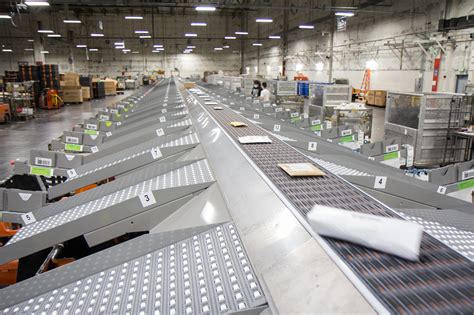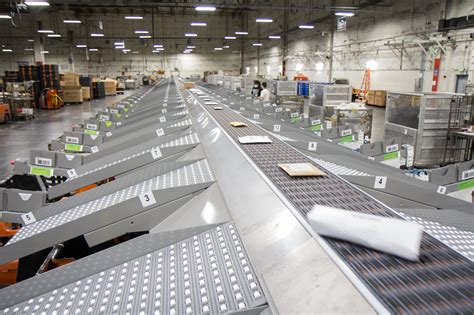the parcel has been sorted at the sorting center ,parcel sorting machine,the parcel has been sorted at the sorting center, You will see a “departed processing center” scan when your package leaves one of these facilities. It means your item has finished sorting at that location and is now being transported to the next facility or hub. This . Looking for replica bags online in India? Shop for the best replica bags from our collection of exclusive, customized & handmade products. . Women Handbags Leather Luxury Designer HandBag Shoulder Crossbody Bags Brand Messenger Bag Luxury Tote Monogram Bag For Ladies Brand Bag Her (7) ₹ 6,591 .

In the fast-paced world of logistics and e-commerce, the role of sorting centers cannot be overstated. Sorting centers serve as the backbone of efficient parcel delivery systems, ensuring packages are distributed correctly and expediently to their final destinations. One crucial aspect of parcel handling is the sorting process, where parcels are divided into categories based on various factors such as destination, size, and type of shipment. The phrase "The parcel has been sorted at the sorting center" represents the completion of a critical step in the logistics chain, one that ensures smooth and timely delivery.
In this article, we will explore the intricacies of parcel sorting, the various roles involved, the technologies that facilitate the process, and how the sorting system works to ensure parcels are delivered to the right place at the right time.
What is a Sorting Center?
A sorting center is a facility that receives parcels and packages from different sources (such as local couriers, e-commerce platforms, or retail stores) and sorts them based on specific criteria to streamline the shipping process. Sorting centers play a pivotal role in the movement of goods from one point to another, serving as an intermediary station before parcels are forwarded to their final destinations.
Parcels can be categorized based on various factors, including:
1. Destination: Parcels are sorted into containers based on the region, country, or city to which they are headed.
2. Type of Shipment: There are different categories such as express, standard, or international parcels.
3. Registration Status: Some parcels are registered, requiring more detailed handling and tracking, while others are unregistered.
4. Size and Weight: Larger parcels may need different handling or packaging than smaller items, influencing their sorting process.
Once sorted, the parcels are transferred to the appropriate carriers or logistics providers to continue their journey toward delivery.
The Parcel Sorting Process
Parcel sorting is a multi-step process that involves several stages of handling and organization. Understanding this process is essential for appreciating the role sorting centers play in modern logistics.
1. Receiving Parcels
The sorting process begins when parcels are received at the sorting center. These parcels may come from various sources, including warehouses, regional hubs, or directly from customers. Upon arrival, parcels are scanned and identified using barcodes or RFID tags, which are crucial for tracking their progress through the sorting system.
2. Initial Scanning and Categorization
Once the parcels are received, the first step in the sorting process is scanning. Scanners read the barcode or RFID tags on each package, allowing the system to identify the parcel’s destination, size, and weight. This initial scan helps categorize parcels for further sorting based on factors like destination, size, or special requirements.
3. Sorting by Destination
After categorization, parcels are sorted based on their destination. This is one of the most important stages in the sorting process, as it determines the most efficient route for delivery. Automated sorting systems (such as high-speed sorting machines) are often used to segregate parcels by destination country, region, or city. These machines use advanced algorithms and technologies, such as optical character recognition (OCR) and infrared sensors, to quickly and accurately sort the parcels into the right containers or bins.
4. Handling Special Shipments
Certain parcels may require special handling. For example, international shipments or parcels containing fragile or hazardous materials may need to be separated and processed differently. In these cases, sorting centers will have dedicated teams or specialized equipment to ensure these parcels are treated with care and meet regulatory requirements.
5. Final Sorting and Dispatch
After the parcels have been grouped by destination, the final stage of sorting takes place. Here, parcels are either loaded onto delivery trucks or transferred to smaller distribution hubs, depending on their final destination. This stage is critical in ensuring that parcels are dispatched promptly and efficiently.
6. Exportation of Parcels
When a parcel is marked as "exported," it means that it is leaving the country of origin. This often indicates that the parcel has passed through customs checks, been cleared for international shipping, and is now in transit to another country. The exportation process involves checking the parcel's documentation, ensuring it complies with international shipping regulations, and verifying any applicable customs duties or taxes.
Parcel Sorter Roles and Responsibilities
Parcel sorters are the individuals responsible for overseeing and performing the sorting of parcels at sorting centers. Their job description can vary depending on the size of the facility, the level of automation, and the specific sorting system in use. However, the core responsibilities of a parcel sorter generally include the following:

the parcel has been sorted at the sorting center Sophisticated fake websites and social media ads falsely claiming to offer extreme BAPE discounts up to 90% off hoodies, t-shirts and other popular items aim to dupe fashion fans. This guide breaks down exactly how this scam .
the parcel has been sorted at the sorting center - parcel sorting machine